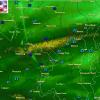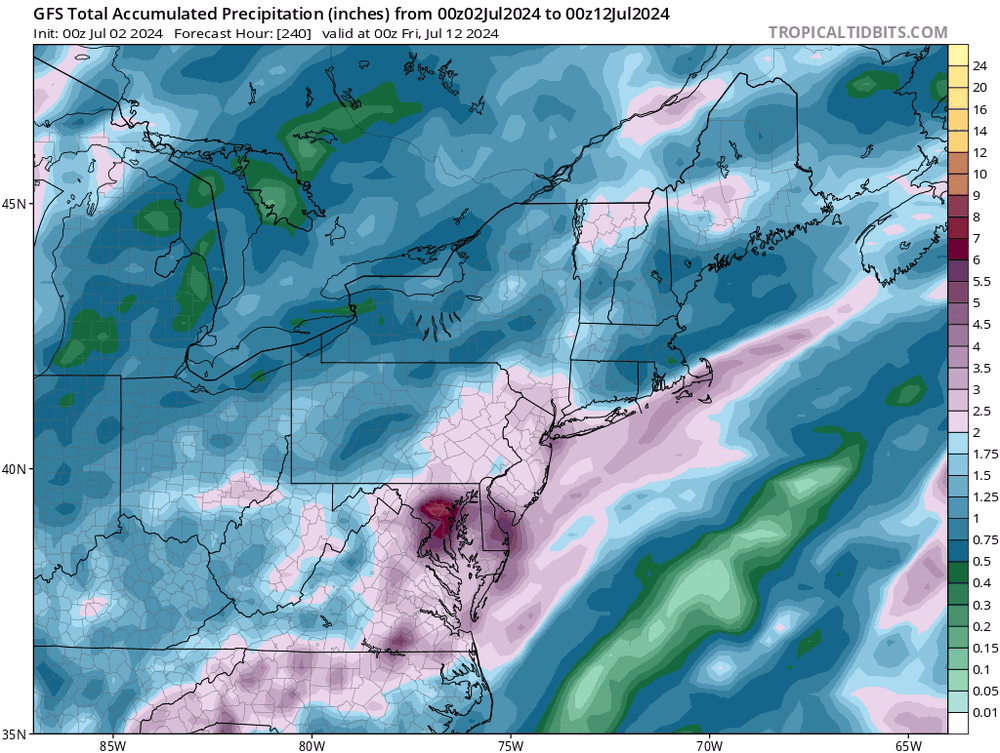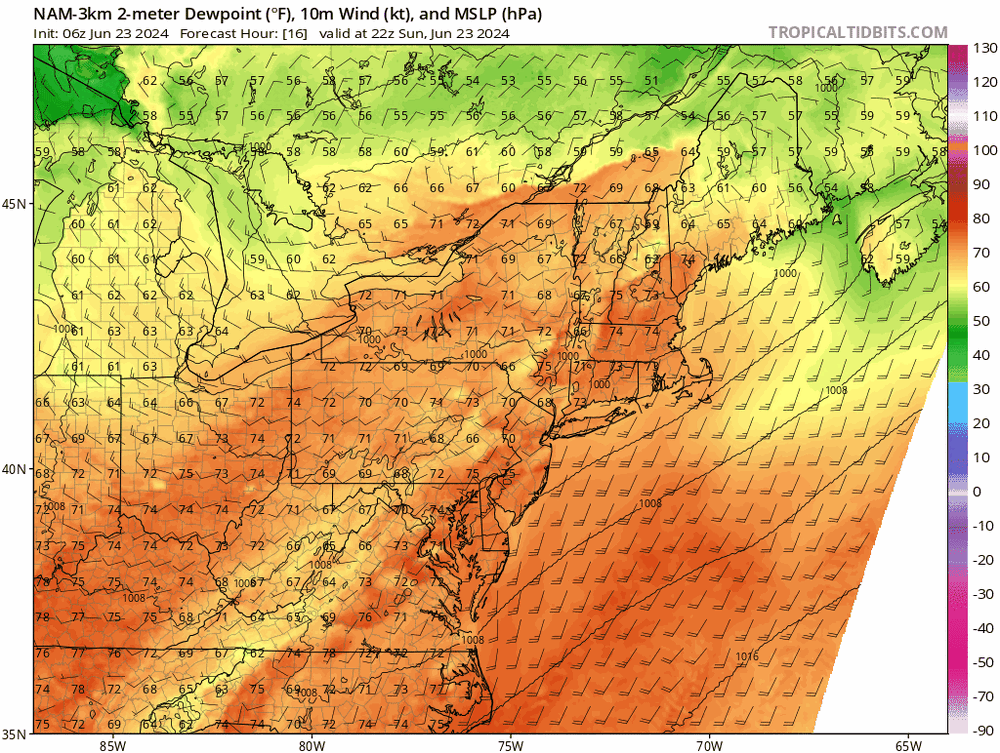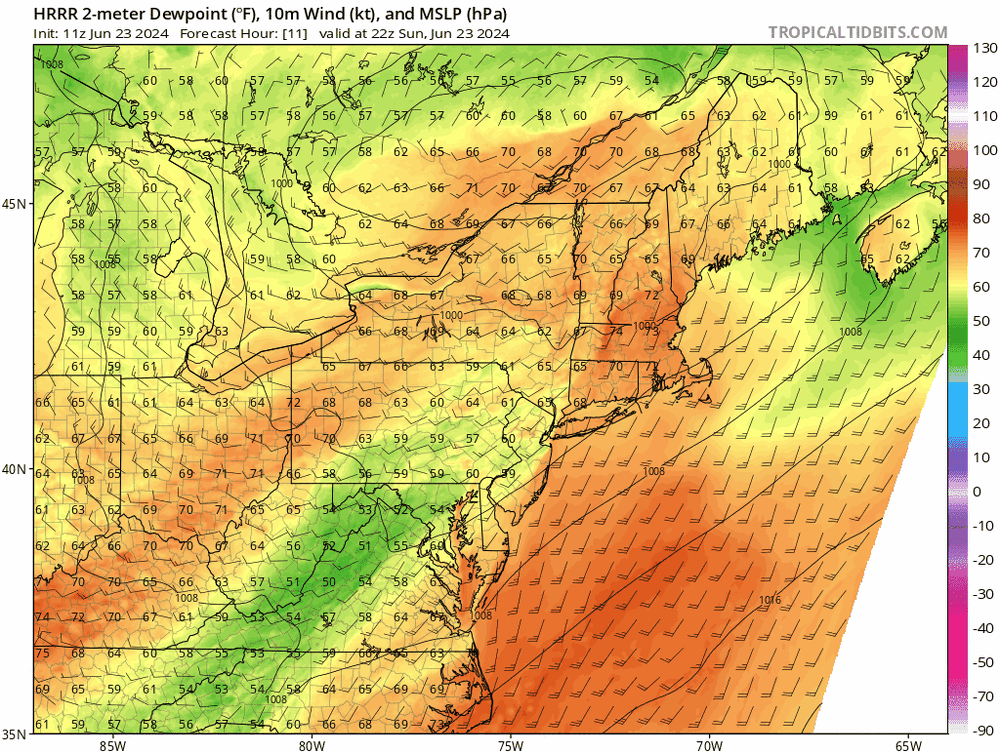-
Posts
3,017 -
Joined
-
Last visited
Content Type
Profiles
Blogs
Forums
American Weather
Media Demo
Store
Gallery
Everything posted by high risk
-
Getting really concerned about trying to get meaningful rainfall this week. It’s still on the table, but it’s far from a sure thing, and lowering model QPF reflects that. It looks like 2 chances: 1) a line of convection on the front Wednesday evening which has potential for big localized totals, but will there be breaks in the line, and might it weaken if it arrives too late? 2) moisture moving from coastal areas back to the northwest Friday. The best rains will be east and southeast of us, but can we still get a modest soaking? Models now still have us within the “good” rain, but we’re getting dangerously close to the back edge, and any further shift east could really screw us. I wouldn’t want to be too far west of DC, as things currently look, for round 2.
-
Credit the CAMS which were hinting at a few showers developing along the front after dark. Heavy downpour in the Columbia/Ellicott City area.
-
They're dry, but I wouldn't say "suddenly". Things have been trending towards very limited coverage over all runs from the past couple of days. Still some small chance this evening, but I don't see how we generate storms tomorrow with lowering dew points and (light) north winds.
-
Several consecutive HRRR cycles show convection, focused mainly northwest of I-95 but with some possibility for those further east in central and northern MD, after dark.
-
MRGL for the 4th. There will be convection in the area later in the day, but shear is really meh. Still, with a hot, well-mixed boundary layer, a few stronger wind gusts can't be ruled out. What's interesting is that there is a a weak consensus for this being an event for DC and points south, but there are still a few CAM solutions that get points north of DC in on the action too.
- 1,696 replies
-
- severe
- thunderstorms
- (and 5 more)
-
-
CAMs have swung back and again look decent for the I-95 corridor, BUT those solutions are contingent upon heating into the 90s. It does look like there is some clearing approaching, and I would expect us to rapidly torch if the sun emerges, but we'll see how this plays out.
- 1,696 replies
-
- 12
-

-

-
- severe
- thunderstorms
- (and 5 more)
-
I'm right on the edge and getting massively disappointed. It's worse, because the 00Z CAMs took a huge step in the wrong direction for tomorrow.
-
Huge spread in CAM solutions for both today and tomorrow. After looking at the HRRR and NAM Nest, I was ready to write off severe potential this evening and hope for a weakening area of storms to arrive from the northwest later tonight. But all 3 HiRes Windows have significant convective signals for the early evening hours with modest instability and deep-layer shear (and even a bit of low-level shear, if you're really feeling frisky). Do we trust the 2 better models or the agreement of the other 3? For Sunday, being further south and east will ramp up your severe probabilities considerably, but there is still a healthy overall signal for the I-95 corridor in an environment with stronger instability and deep-layer shear than today.
- 1,696 replies
-
- 15
-

-

-
- severe
- thunderstorms
- (and 5 more)
-
Of course, right after I blow off Saturday, the 12Z HRRR pulls me back in with an impressive convective evolution for northern MD with some interesting wind profiles.
- 1,696 replies
-
- 3
-

-

-

-
- severe
- thunderstorms
- (and 5 more)
-
Yeah, I'm still worried about this being an Eastern Shore show on Sunday - hoping that the slower trends continue.
- 1,696 replies
-
- 1
-

-
- severe
- thunderstorms
- (and 5 more)
-
Other than a couple of isolated morning showers and maybe a few dying late evening showers, I'm not seeing a lot of legit rain chances on Saturday unless something changes. I've resigned now to pulling for Sunday. I was surprised to the SLGT, but the Euro is much slower with the front, and the GFS/GEFS seem to be trending that way. Would be a decent SVR (and possibly a heavy rainfall) event Sunday if the slower front idea is correct.
- 1,696 replies
-
- 4
-

-

-
- severe
- thunderstorms
- (and 5 more)
-
The timing of the front looks awful. We need it to slow down, as a Sunday morning frontal passage won't bring the goods, and we'll watch things like up for the beaches of MD/DE/southeast VA. Our best hope is that there are indications of a modest lead shortwave Saturday evening. Organized storms may fire Saturday afternoon to our west/northwest and roll through during the evening.
- 1,696 replies
-
- 3
-

-
- severe
- thunderstorms
- (and 5 more)
-
Only if the main show fizzles out too, which looks unlikely. The models had the idea of forcing for a small-scale round 1, but they put it in northern MD instead of southern. They've been very consistent about a more widespread area of storms rolling in from the west later this evening, and that appears to be on track. If the models are off and that craps out, then a post-mortem will be needed.
- 1,696 replies
-
- 5
-

-
- severe
- thunderstorms
- (and 5 more)
-
There is actually some very solid agreement now in the 12Z guidance. There is a round 1 in the 21-23Z time frame which has a cluster or broken line of cells, focused mostly north of DC, which would have some significant wind potential. There is then a more widespread round 2 later in the evening that would bring welcome rain to most of the area.
- 1,696 replies
-
- 4
-

-
- severe
- thunderstorms
- (and 5 more)
-
Yep. You have to toss the HRRR solutions, because it has no instability to work with when it tries to initiate convection.
- 1,696 replies
-
- severe
- thunderstorms
- (and 5 more)
-
Maybe. The HRRR is on its own with such an early round 1. Its doing weird things with the mixing again, but I'm not sure if that is driving the early show, or if it's just different handling of the forcing. If things hold off until later when the shear increases, I think there is some higher end wind potential. Heck, if just we boost the dew points in the HRRR but keep its timing, the still sizable downdraft CAPE might overcome the weak shear and give some pockets of higher winds.
- 1,696 replies
-
- severe
- thunderstorms
- (and 5 more)
-
Correct. The HRRR is the earliest with convection, and the shear won't increase until later in the day, so its early afternoon storms are not exciting. That said, I'd take its solution in a heartbeat, as it has multiple rounds of storms and good rainfall. The 18Z NAM Nest has severe storms, as it waits until later when the shear has improved a lot, but some people (me!!!) miss out, and there is no round 2 later in the evening or overnight. That run legitimately pissed me off.
- 1,696 replies
-
- severe
- thunderstorms
- (and 5 more)
-
One problem, though, is that the better flow aloft seems to be lagging behind and may arrive until after the front passes. Still, I would take the GFS timing of the shortwave. The 00Z NAM timing is slower, which is not what we want for this system.
- 1,696 replies
-
- severe
- thunderstorms
- (and 5 more)
-
The HRRR definitely won't be right, but even the NAM Nest lowers dew points a couple of degrees this afternoon (before a rise again later in the day). Mid-level temps are fairly warm, so if there is some truth to the idea of mixing, but at a far lower magnitude than shown by the HRRR, that could make the difference between convection firing or not.
- 1,696 replies
-
- severe
- thunderstorms
- (and 5 more)
-
- 1,696 replies
-
- 8
-

-
- severe
- thunderstorms
- (and 5 more)
-
I think that our best bet for severe and more widespread coverage is the scenario shown by both the 12/18Z NAM Nest. Storms fire in the mid to late afternoon along some sort of pre-frontal trough and get organized as they sweep east, in an environment with modest shear and good downdraft CAPE. At least some coverage of damaging winds would be likely. A second line tries to form behind it a few hours later, but that affects areas generally east of I-95. The HRRR goes for a couple of rounds in the early to mid evening, which would be great for rainfall potential, but the fact that the reflectivities are low and the rainfall is super light give me a lot of doubts about that scenario.
- 1,696 replies
-
- 7
-

-
- severe
- thunderstorms
- (and 5 more)
-
Sunday has some potential, I guess, although flow looks to be very light. But I guess that there would be a localized downburst threat with the deep, well-mixed boundary layer. One thing I don't like: the signal seems to be focused more east of here, and I've seen too many scenarios in which storms initiate over us but don't really mature until cross the Bay. At this point, though, I just want some freaking rain.
- 1,696 replies
-
- 2
-

-
- severe
- thunderstorms
- (and 5 more)
-
Interesting that Dulles has been at 59 for a couple of hours now.
- 1,696 replies
-
- severe
- thunderstorms
- (and 5 more)
-
KDCA dew point is still 68, but KBWI and KIAD have dropped into the low 60s
- 1,696 replies
-
- severe
- thunderstorms
- (and 5 more)






